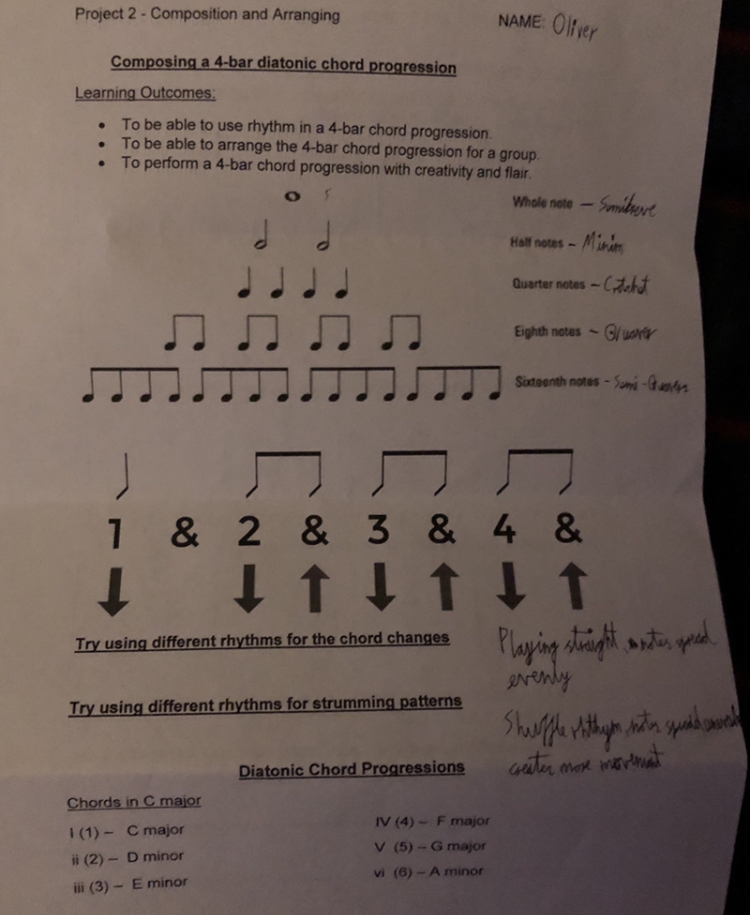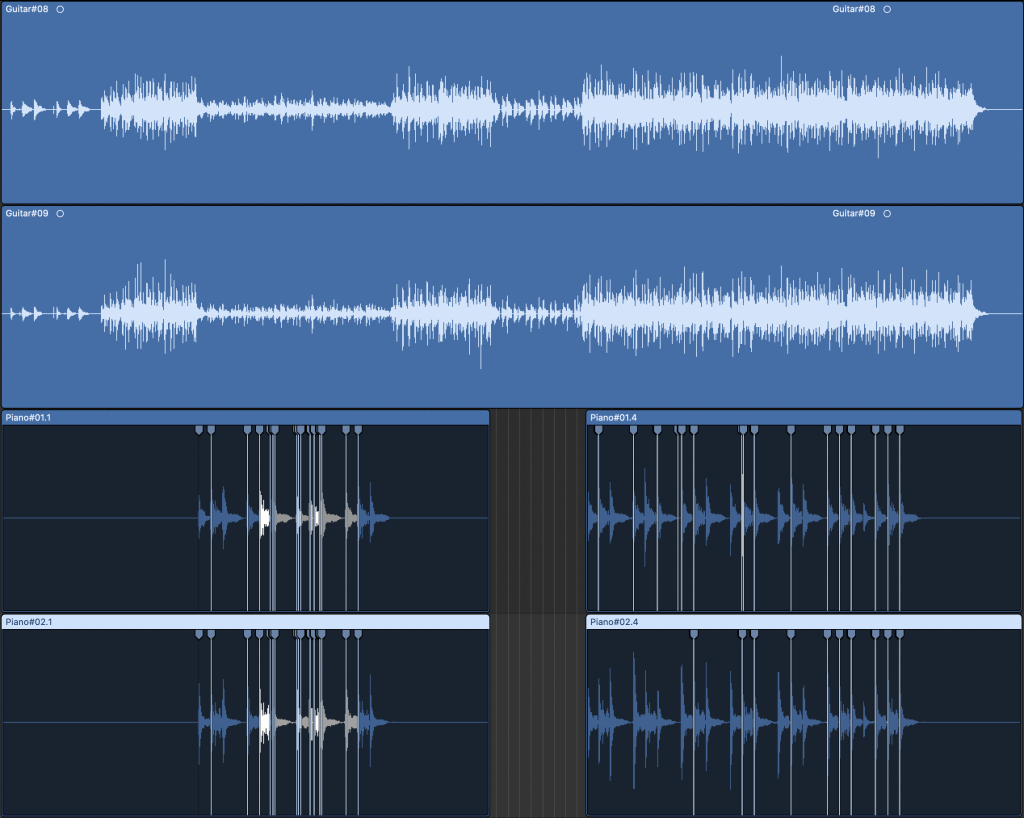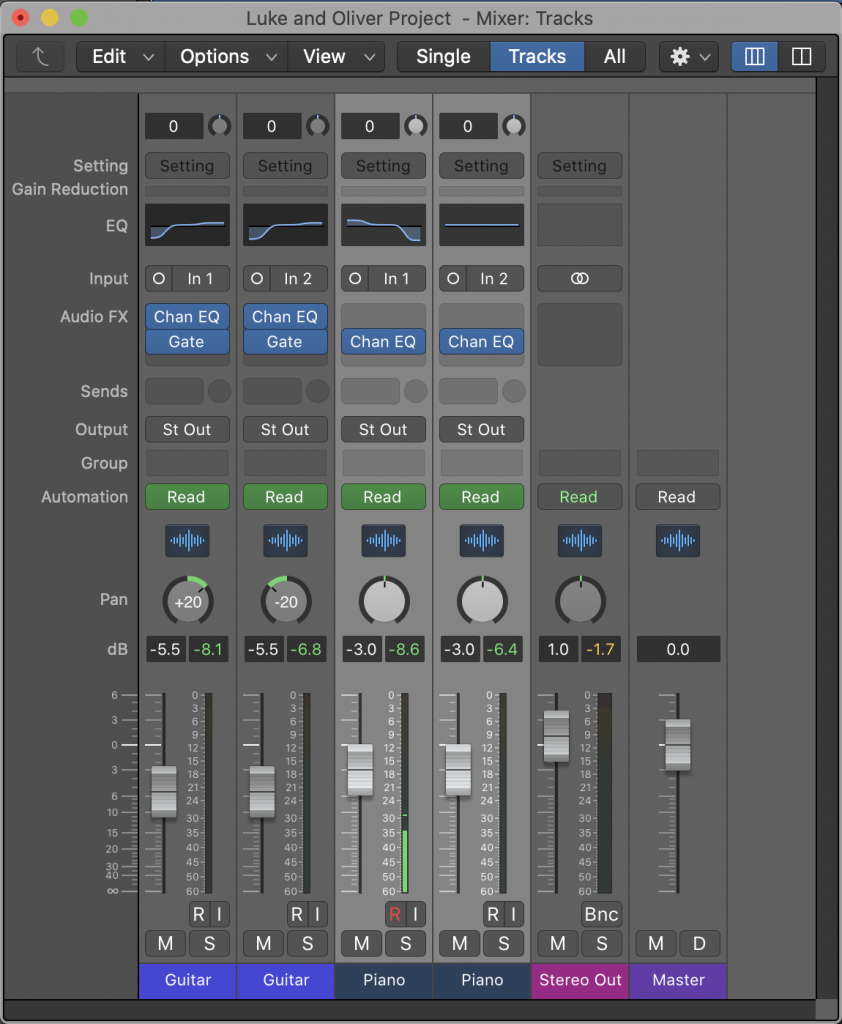Composition
In this songwriting lesson we experimented with writing chord progressions, either based on chance by method of rolling dice or by picking chords at random. We were split up into pairs and with my partner we came up with a simple chord progression with the help of some dice; I must say that I wasn’t a huge fan of it but the idea here was to experiment and to understand that writing chord progressions doesn’t need to be an arduous process if you have the tools/knowledge.
Our next songwriting lesson had us focusing on rhythm, how to play around with it, and how to understand its use. To understand rhythm however, you first need to get to grips with musical notation, which is what you see below. We covered the five most common musical note in both American and English naming, going from semibreves all the way down to semi-quavers. We talked through the differences between playing straight and shuffle rhythm, as well as the uses of both, where you would expect to find them, etc.

This lead us on to strumming patterns. Typically, you will find that the stronger notes are played on the onbeat while the slightly weaker notes are played on the offbeat; so in a “1 and 2 and 3 and 4 and”, the onbeats are the numbers and the offbeats occur with every “and”. Let’s take a guitar in our example, on every onbeat you strum down for a stronger sound, whilst every offbeat you strum upwards for a weaker sound. One of the most common strumming patterns uses the “1 and 2 and 3 and 4 and” but removes any strumming on the first “and” as well as the “3”, so instead of [down, up, down, up, down, up, down, up] it becomes [down, down, up, up down, up].

One of the most common strumming patterns uses the “1 and 2 and 3 and 4 and” but removes any strumming on the first “and” as well as the “3”, so instead of [down, up, down, up, down, up, down, up] it becomes [down, down, up, up down, up]. Using this new chord progression I wrote, we opted for a more stripped back strumming pattern when experimenting, the difference is shown in the video below where I transition from the common pattern to my new pattern.
Next, we took on the challenge of writing a song as a band. Our starting point was deciding which key we decided we wished to work within, which ended up being D.
This week we focused on melody, we started out by looking at three well-known examples and analysing them.
The first piece was “La Donna e Mobile” by Guiseppie Verdi, from his opera Rigoletto. It is a very repetitive melody that was composed with the express purpose of lasting long in the memory of all who heard, I think Verdi was successful in his attempts as this is one of the most enduring melodies in history. What makes it so memorable is the simplicity of it, and the repetition; after only a few listens to the melody, you are already familiarised with it due to how easy it is to follow and can go along with the tune for every repetition.
The next melody we analysed was The White Stripes’ instantly recognisable “Seven Nation Army”. This follows a tried and tested method in which you utilise shape, by going either higher or lower over the course of the melody. However, this time it creates a loop in a sense as the bass takes us higher at first, then back down, before repeating again which is what creates this cyclical melody.
Our final melodic analysis was on “Mr. Brightside”, The Killers’ iconic hit. The melody in this song comes from the vocals, and what makes this rather interesting is that the melody isn’t really very melodic. For the vast majority of this song, Brandon Flowers sings at the same note, but his vocals are given a different sound due to the instrumentation behind it. When the instrumentation goes low, his vocals sound higher relative to it, and when the instrumentation goes higher, his vocals sound lower. This is what keeps the monotonous melody sound fresh.
With the melody here, what I tried to do was keep things simple, and take the higher/lower method to create something interesting. A simple three notes each bar which ascend for the first three bars before descending for the fourth. It sticks in your mind (or it does mine, at least) and keeps things simple. One thing we tried but didn’t get to record was changing the timing of the melody – we started on the 1 of each bar, but Nic recommended we change to start on the 1 AND instead. Delaying the notes by half a beat keep that simplicity I wanted but make it more interesting.
In today’s session, Luke and I worked on our composition. The week prior when I wasn’t in attendance, Luke worked on a solo version of what we’ve done in the past, playing the chords and melody simultaneously on the keyboard. When I came in I struggled to arrange us in a way that works with the introduction of an acoustic guitar. After a few different methods we landed on Luke starting us off and I would come in later as the keyboard melody drops out – I don’t think we were very successful with it personally. Firstly, we didn’t rehearse enough to have it down. Secondly, I could’ve played around with my strumming patterns and dynamics more as I seemed to play at a rather stable level which became stale. And finally I finished on the wrong note, in this piece we should’ve ended with a resolution.
At times it came together and we had hints of positivity in what we were making, but unfortunately that video didn’t display the composition as well as it could’ve done, due to poor performances from us mostly. I like the different sections we have, I really do think there is something in there, it’s a matter of refining them and bringing out the good parts.
On the negative side, our timing was all over the place as Luke wasn’t able to maintain 4/4 timing throughout and I didn’t quite spot that issue prior to this performance, leaving us out of time with each other and the song to sound very messy. We remedied this by deciding to have me tapping along with the track so it is easier to count ourselves in. I struggled with the barre chords a lot. Almost every chord sounded unpleasant and drastically reduced the quality of the composition, so I am now to use a capo on the 8th fret as well as changing some of the chords to make the piece easier to play.
Noticeable improvements on this latest video are to do with timing and structure. With Nic’s help we were given recommendations regarding the structure of the song, allowing us to create something that resembles an actual song rather than a bunch of sections hashed together. With that in mind, we came across a new issue – length. Due to us not recording a practice previous to this video, we were unaware that the composition had made it to five minutes before Nic stopped us; had he not stopped us we were probably going to reach the six minute mark. Completely unnecessary for a song of this style, we essentially halved every section which would give us a lovely three minute piece, far more palatable. After this performance we tried it again but with everything halved and it worked far better.
Another improvement we made was changing the chords to fit the key of the song properly, as well as introducing some really beautiful chords to the mix. This added variety and – when combined with some gentle strumming during the verses – a sense of momentum within the song, which had sounded a little too slow and stagnant up until this point. With practice and considerations to the arrangement, we would be ready to record.
This was an interesting process, and one that I am already repeating and working through in my own time, as I find songwriting and musical creation fascinating. Picking up a few tricks along the way always helps, and I certainly learnt from this. I enjoy the creative aspect of songwriting massively. I fully understand that collaboration is a key aspect of music and I truly love the idea of it, but in this instance I don’t think it worked as well as we had hoped. In my eyes, good collaboration is built on chemistry between artists, and Luke and I didn’t have that chemistry, whether this hindered us or not, I don’t know, but I don’t feel that we were an effective partnership. In future collaboration I now know to look for people who there is a spark with, and more of an understanding on a personal level. On a more positive note, I believe that my ability really grew in these weeks! Knowing things such as how to vary strumming patterns effectively and not just for the sake of it, and how to utilise simple things to create interesting arrangements, is something I will definitely take forward with me as I challenge myself further with songwriting.
Recording
As Luke and I attend different days, he recorded his part on the Monday whilst I recorded mine on the Tuesday. The setup for my recording was rather simple as we just needed to record acoustic guitar; this involved tuning the guitar itself, of course, and ensuring I was ready and warmed up before my takes. The meat of the setup, however, was picking out the correct microphone, positioning it correctly, and using the DAW properly. We chose a condenser microphone as it offers higher sound quality than a dynamic microphone and the highest frequency range, this is helpful for an acoustic guitar as we want to hear the full range of the strings in the best possible quality. This microphone was set up around 2-3 inches away from the sound hole as that would produce the largest and fullest sound, which is what I wanted in the composition.
When it came to recording my part, I put on the headphones and attempted to play along to Luke’s take of the piece on piano. This is where our first issue was found as Luke had reverted back to missing that 4/4 timing due to me being absent during his recording. This made it impossible for me to record a successful take with his piano in my ears, so I decided I would do a dry run with no piano as I had a decent grasp of the timing we needed, but unfortunately that would mean Luke needed to retake his part. Had this been a studio session we had paid for, we would be in trouble, rerecording a part due to such a simple error would be costly in terms of money and time. It took me a few attempts to get a clean take but I made it and we moved on to recording Luke’s redo of the piano part.
For this we needed to wheel the piano into the recording room, ensuring everyone pushed it safely and with great caution, after that was rigging the mics. For this we needed a second condenser microphone as the combination of two channels would create a larger sound that could even be panned in the mix, essentially giving us greater freedom. Upon recording we realised that the original arrangement of the song, starting with piano, wasn’t feasible given I recorded first and we couldn’t find a click that worked just right for us. With that realisation we decided to change the composition on the fly and just begin it with both of us coming in together, meaning Luke could just count in and join in right away, with my guitar keeping the tempo regular enough for him to play along. Upon listening back to the recording, there were still irregularities with the tempo but due to time constraints we had to make do and accept that we had the best takes given the circumstances – not an ideal situation, but one we found ourselves in and one we would need to work with.
The recording process for our song was a little all over the place truthfully. We needed retakes, we were forced to alter the song mid-recording, and neither of us were on form when it came to the instrumentation. More rehearsals and better communication of certain aspects would’ve saved us a lot of trouble, but that is now something for us to consider in the future. One major lesson learnt was to really nail down the song before going in to record, not doing so leads to a lot of stress when you finally get down to the recording, practicing first will save a headache later on. On the bright side, I did enjoy being in the studio, playing guitar, communicating with whoever is at the mixing desk, and taking charge of the situation when required. I felt like I problem solved effectively on the fly, and it resulted in an adequate product, which is better than what I foresaw personally.
Mixing
After working on the songwriting project as part of a duo, we landed on a final composition, recorded it, and headed to the Mac suite to mix it all together.



